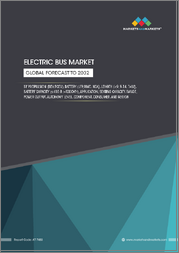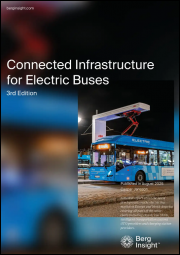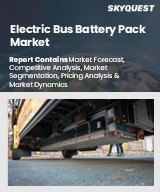
|
시장보고서
상품코드
1781468
세계의 연료전지 전기버스 시장 조사 보고서 : 산업 분석, 규모, 점유율, 성장, 동향 및 예측(2025-2033년)Global Fuel Cell Electric Buses Market Research Report- Industry Analysis, Size, Share, Growth, Trends and Forecast 2025 to 2033 |
||||||
세계의 연료전지 전기버스 시장 규모는 2024년 14억 9,000만 달러에서 2033년에는 110억 7,000만 달러로 성장하고, 2026-2033년의 예측 기간에 24.93%의 연평균 복합 성장률(CAGR)을 나타낼 전망입니다.
연료전지 전기버스 시장은 지속 가능한 대중교통 솔루션에 대한 긴급한 수요에 힘입어 큰 변화의 조짐을 보이고 있습니다. 도시 지역의 오염 수준 증가와 교통 체증에 대응하기 위해 연료전지 기술은 기존 디젤 버스를 대체할 수 있는 실행 가능한 대안을 제시하고 있습니다. 이 차량은 배기가스를 배출하지 않을 뿐만 아니라 배터리 전기버스에 비해 주행거리가 길고, 연료 보급 시간도 짧습니다. 탄소 배출량 감축을 위한 정부 및 지방 자치 단체의 적극적인 노력은 연료전지 인프라에 대한 투자를 촉진하고, 이 혁신적인 버스가 대중 교통 시스템에 널리 채택될 수 있는 길을 열어주고 있습니다.
또한, 연료전지 기술의 발전으로 전기버스의 성능과 비용 효율성이 향상되고 있습니다. 연구 개발의 초점은 연료전지의 효율을 높이고 제조 비용을 절감하여 교통 당국이 이러한 차량을 더 쉽게 이용할 수 있도록 하는 것입니다. 제조업체들의 기술 혁신이 진행됨에 따라 시장에서는 도심 출퇴근부터 도시 간 이동까지 다양한 운행 수요에 맞추어 연료전지 버스 모델이 다양화될 것으로 보입니다. 연료전지 버스가 기존 시스템에 원활하게 통합될 수 있도록 함으로써 대중교통 네트워크의 다양한 수요를 충족시키기 위해서는 이러한 적응성이 매우 중요합니다.
또한, 연료전지 전기버스 시장의 성장을 위해서는 민관의 협력이 필수적입니다. 수소 생산 및 공급 인프라 개발을 위한 파트너십은 현재의 도입 장벽을 극복하는 데 매우 중요합니다. 더 많은 이해관계자들이 연료전지 기술의 잠재력을 인식함에 따라 지속 가능한 교통 솔루션에 대한 집단적 노력에 힘입어 연료전지 시장은 빠르게 성장할 것으로 예측됩니다. 대중교통의 미래는 점점 더 연료전지 전기버스로 기울어지고 있으며, 친환경 도시 모빌리티의 핵심으로 자리매김하고 있습니다.
당사의 보고서는 고객에게 다양한 산업과 시장에 대한 종합적이고 실용적인 통찰력을 제공하기 위해 세심하게 작성되었습니다. 각 보고서는 시장 상황을 완전히 이해하기 위해 몇 가지 중요한 요소를 포함하고 있습니다.
시장 개요: 정의, 분류, 산업 현황 등 시장에 대한 자세한 소개.
시장 역학: 시장 성장에 영향을 미치는 주요 촉진요인, 억제요인, 기회 및 과제를 상세하게 분석합니다. 이 섹션에서는 기술 발전, 규제 변화, 새로운 트렌드 등의 요인을 살펴봅니다.
세분화 분석 : 제품 유형, 용도, 최종 사용자, 지역 등의 기준에 따라 시장을 명확한 부문으로 세분화합니다. 이 분석을 통해 각 부문의 실적과 미래성을 파악할 수 있습니다.
경쟁 구도: 시장 점유율, 제품 포트폴리오, 전략적 이니셔티브, 재무 실적 등 주요 시장 진출기업의 종합적인 평가. 주요 기업들이 채택하고 있는 경쟁 역학 및 주요 전략에 대한 고찰을 담고 있습니다.
시장 예측 : 과거 데이터와 현재 시장 상황을 바탕으로 일정 기간 시장 규모와 성장 추세를 예측합니다. 여기에는 정량적 분석과 미래 시장 궤적을 보여주는 그래프 표시가 포함됩니다.
지역 분석 : 지역별 시장 성과를 평가하고 주요 시장 및 지역 동향을 파악합니다. 지역 시장 역학 및 비즈니스 기회를 이해하는 데 도움이 됩니다.
새로운 트렌드와 기회 : 현재 시장 동향과 새로운 시장 동향, 기술 혁신, 잠재적 투자 대상 부문을 식별합니다. 향후 개발 및 성장 전망에 대한 통찰력을 담고 있습니다.
목차
제1장 서문
제2장 주요 요약
- 시장 하이라이트
- 세계 시장 현황
제3장 연료전지 전기버스 산업 분석
- 서론 : 시장 역학
- 시장 성장 촉진요인
- 시장 성장 억제요인
- 시장 기회
- 산업 동향
- Porter의 Five Forces 분석
- 시장 매력 분석
제4장 밸류체인 분석
- 밸류체인 분석
- 원료 분석
- 원료 리스트
- 원료 제조업체 리스트
- 주요 원료 가격 동향
- 잠재적 바이어 리스트
- 마케팅 채널
- 직접 마케팅
- 간접 마케팅
- 마케팅 채널 발전 동향
제5장 세계의 연료전지 전기버스 시장 분석 : 기술별
- 기술별 개요
- 기술별 과거 및 예측 데이터 분석
- 고체 고분자형 연료전지
- 인산형 연료전지
- 고체 산화물 연료전지
- 기타
제6장 세계의 연료전지 전기버스 시장 분석 : 용도별
- 용도별 개요
- 용도별 과거 및 예측 데이터 분석
- 공공 교통
- 민간 운송
- 기타
제7장 세계의 연료전지 전기버스 시장 분석 : 출력별
- 출력별 개요
- 출력별 과거 및 예측 데이터 분석
- 100kW 이하
- 100kW-200kW
- 200kW 이상
제8장 세계의 연료전지 전기버스 시장 분석 : 컴포넌트별
- 컴포넌트별 개요
- 컴포넌트별 과거 및 예측 데이터 분석
- 연료전지 스택
- 배터리 시스템
- 전동 모터
- 기타
제9장 세계의 연료전지 전기버스 시장 분석 : 지역별
- 지역별 전망
- 서론
- 북미의 판매 분석
- 개요, 분석과 예측
- 북미 : 부문별
- 북미 : 국가별
- 미국
- 캐나다
- 멕시코
- 유럽의 판매 분석
- 개요, 분석과 예측
- 유럽 : 부문별
- 유럽 : 국가별
- 영국
- 프랑스
- 독일
- 이탈리아
- 러시아
- 기타 유럽
- 아시아태평양의 판매 분석
- 개요, 분석과 예측
- 아시아태평양 : 부문별
- 아시아태평양 : 국가별
- 중국
- 인도
- 일본
- 한국
- 호주
- 동남아시아
- 기타 아시아태평양
- 라틴아메리카의 판매 분석
- 개요, 분석과 예측
- 라틴아메리카 : 부문별
- 라틴아메리카 : 국가별
- 브라질
- 아르헨티나
- 페루
- 칠레
- 기타 라틴아메리카
- 중동 및 아프리카의 판매 분석
- 개요, 분석과 예측
- 중동 및 아프리카 : 부문별
- 중동 및 아프리카 : 국가별
- 사우디아라비아
- 아랍에미리트(UAE)
- 이스라엘
- 남아프리카공화국
- 기타 중동 및 아프리카
제10장 연료전지 전기버스 기업 경쟁 구도
- 연료전지 전기버스 시장 경쟁
- 제휴/협력/계약
- 인수합병(M&A)
- 신제품 발표
- 기타 개발
제11장 기업 개요
- 주요 기업의 시장 점유율 분석
- 시장 집중도
- Ballard Power Systems
- Proton Motor Fuel Cell GmbH
- Hyundai Motor Company
- Daimler AG
- Wrightbus
- Van Hool NV
- New Flyer Industries
- Solaris Bus & Coach
- Yutong Bus
- Zhongtong Bus Holding
- Hyzon Motors
- Nikola Corporation
- Hino Motors
- Tata Motors
- Ashok Leyland
Global Fuel Cell Electric Buses Market size is anticipated to grow from USD 1.49 Billion in 2024 to USD 11.07 Billion by 2033, showcasing a robust Compound Annual Growth Rate (CAGR) of 24.93% during the forecast period of 2026 to 2033.
The fuel cell electric buses market is on the cusp of a significant transformation, driven by the urgent need for sustainable public transportation solutions. As urban areas grapple with increasing pollution levels and traffic congestion, fuel cell technology presents a viable alternative to traditional diesel buses. These vehicles not only produce zero emissions but also offer longer ranges and quicker refueling times compared to battery electric buses. The growing commitment from governments and municipalities to reduce carbon footprints is propelling investments in fuel cell infrastructure, paving the way for widespread adoption of these innovative buses in public transit systems.
In addition, advancements in fuel cell technology are enhancing the performance and cost-effectiveness of electric buses. Research and development efforts are focused on improving fuel cell efficiency and reducing production costs, making these vehicles more accessible to transit authorities. As manufacturers continue to innovate, the market is likely to see a diversification of fuel cell bus models tailored to various operational needs, from urban commuting to intercity travel. This adaptability will be crucial in meeting the diverse demands of public transportation networks, ensuring that fuel cell buses can seamlessly integrate into existing systems.
Furthermore, the collaboration between public and private sectors is essential for the growth of the fuel cell electric buses market. Partnerships aimed at developing hydrogen production and distribution infrastructure will be critical in overcoming current barriers to adoption. As more stakeholders recognize the potential of fuel cell technology, the market is expected to expand rapidly, driven by a collective commitment to sustainable transportation solutions. The future of public transit is increasingly leaning towards fuel cell electric buses, positioning them as a cornerstone of eco-friendly urban mobility.
Our reports are meticulously crafted to provide clients with comprehensive and actionable insights into various industries and markets. Each report encompasses several critical components to ensure a thorough understanding of the market landscape:
Market Overview: A detailed introduction to the market, including definitions, classifications, and an overview of the industry's current state.
Market Dynamics: In-depth analysis of key drivers, restraints, opportunities, and challenges influencing market growth. This section examines factors such as technological advancements, regulatory changes, and emerging trends.
Segmentation Analysis: Breakdown of the market into distinct segments based on criteria like product type, application, end-user, and geography. This analysis highlights the performance and potential of each segment.
Competitive Landscape: Comprehensive assessment of major market players, including their market share, product portfolio, strategic initiatives, and financial performance. This section provides insights into the competitive dynamics and key strategies adopted by leading companies.
Market Forecast: Projections of market size and growth trends over a specified period, based on historical data and current market conditions. This includes quantitative analyses and graphical representations to illustrate future market trajectories.
Regional Analysis: Evaluation of market performance across different geographical regions, identifying key markets and regional trends. This helps in understanding regional market dynamics and opportunities.
Emerging Trends and Opportunities: Identification of current and emerging market trends, technological innovations, and potential areas for investment. This section offers insights into future market developments and growth prospects.
SEGMENTATION COVERED IN THE REPORT
By Technology
- Proton Exchange Membrane Fuel Cell
- Phosphoric Acid Fuel Cell
- Solid Oxide Fuel Cell
- Others
By Application
- Public Transport
- Private Transport
- Others
By Power Output
- Below 100 kW
- 100-200 kW
- Above 200 kW
By Component
- Fuel Cell Stack
- Battery System
- Electric Motor
- Others
- COMPANIES PROFILED
- Ballard Power Systems
- Proton Motor Fuel Cell GmbH
- Hyundai Motor Company
- Daimler AG
- Wrightbus
- Van Hool NV
- New Flyer Industries
- Solaris Bus & Coach
- Yutong Bus
- Zhongtong Bus Holding
- Hyzon Motors
- Nikola Corporation
- Hino Motors
- Tata Motors
- Ashok Leyland
- The above list can be customized.
TABLE OF CONTENTS
1. PREFACE
- 1.1. Report Description
- 1.1.1 Objective
- 1.1.2 Target Audience
- 1.1.3 Unique Selling Proposition (USP) & offerings
- 1.2. Research Scope
- 1.3. Research Methodology
- 1.3.1 Market Research Process
- 1.3.2 Market Research Methodology
2. EXECUTIVE SUMMARY
- 2.1. Highlights of Market
- 2.2. Global Market Snapshot
3. FUEL CELL ELECTRIC BUSES INDUSTRY ANALYSIS
- 3.1. Introduction - Market Dynamics
- 3.2. Market Drivers
- 3.3. Market Restraints
- 3.4. Opportunities
- 3.5. Industry Trends
- 3.6. Porter's Five Force Analysis
- 3.7. Market Attractiveness Analysis
- 3.7.1 Market Attractiveness Analysis By Technology
- 3.7.2 Market Attractiveness Analysis By Application
- 3.7.3 Market Attractiveness Analysis By Power Output
- 3.7.4 Market Attractiveness Analysis By Component
- 3.7.5 Market Attractiveness Analysis By Regions
4. VALUE CHAIN ANALYSIS
- 4.1. Value Chain Analysis
- 4.2. Raw Material Analysis
- 4.2.1 List of Raw Materials
- 4.2.2 Raw Material Manufactures List
- 4.2.3 Price Trend of Key Raw Materials
- 4.3. List of Potential Buyers
- 4.4. Marketing Channel
- 4.4.1 Direct Marketing
- 4.4.2 Indirect Marketing
- 4.4.3 Marketing Channel Development Trend
5. GLOBAL FUEL CELL ELECTRIC BUSES MARKET ANALYSIS BY TECHNOLOGY
- 5.1. Overview By Technology
- 5.2. Historical and Forecast Data Analysis By Technology
- 5.3. Proton Exchange Membrane Fuel Cell Historic and Forecast Sales By Regions
- 5.4. Phosphoric Acid Fuel Cell Historic and Forecast Sales By Regions
- 5.5. Solid Oxide Fuel Cell Historic and Forecast Sales By Regions
- 5.6. Others Historic and Forecast Sales By Regions
6. GLOBAL FUEL CELL ELECTRIC BUSES MARKET ANALYSIS BY APPLICATION
- 6.1. Overview By Application
- 6.2. Historical and Forecast Data Analysis By Application
- 6.3. Public Transport Historic and Forecast Sales By Regions
- 6.4. Private Transport Historic and Forecast Sales By Regions
- 6.5. Others Historic and Forecast Sales By Regions
7. GLOBAL FUEL CELL ELECTRIC BUSES MARKET ANALYSIS BY POWER OUTPUT
- 7.1. Overview By Power Output
- 7.2. Historical and Forecast Data Analysis By Power Output
- 7.3. Below 100 kW Historic and Forecast Sales By Regions
- 7.4. 100-200 kW Historic and Forecast Sales By Regions
- 7.5. Above 200 kW Historic and Forecast Sales By Regions
8. GLOBAL FUEL CELL ELECTRIC BUSES MARKET ANALYSIS BY COMPONENT
- 8.1. Overview By Component
- 8.2. Historical and Forecast Data Analysis By Component
- 8.3. Fuel Cell Stack Historic and Forecast Sales By Regions
- 8.4. Battery System Historic and Forecast Sales By Regions
- 8.5. Electric Motor Historic and Forecast Sales By Regions
- 8.6. Others Historic and Forecast Sales By Regions
9. GLOBAL FUEL CELL ELECTRIC BUSES MARKET ANALYSIS BY GEOGRAPHY
- 9.1. Regional Outlook
- 9.2. Introduction
- 9.3. North America Sales Analysis
- 9.3.1 Overview, Historic and Forecast Data Sales Analysis
- 9.3.2 North America By Segment Sales Analysis
- 9.3.3 North America By Country Sales Analysis
- 9.3.4 United States Sales Analysis
- 9.3.5 Canada Sales Analysis
- 9.3.6 Mexico Sales Analysis
- 9.4. Europe Sales Analysis
- 9.4.1 Overview, Historic and Forecast Data Sales Analysis
- 9.4.2 Europe By Segment Sales Analysis
- 9.4.3 Europe By Country Sales Analysis
- 9.4.4 United Kingdom Sales Analysis
- 9.4.5 France Sales Analysis
- 9.4.6 Germany Sales Analysis
- 9.4.7 Italy Sales Analysis
- 9.4.8 Russia Sales Analysis
- 9.4.9 Rest Of Europe Sales Analysis
- 9.5. Asia Pacific Sales Analysis
- 9.5.1 Overview, Historic and Forecast Data Sales Analysis
- 9.5.2 Asia Pacific By Segment Sales Analysis
- 9.5.3 Asia Pacific By Country Sales Analysis
- 9.5.4 China Sales Analysis
- 9.5.5 India Sales Analysis
- 9.5.6 Japan Sales Analysis
- 9.5.7 South Korea Sales Analysis
- 9.5.8 Australia Sales Analysis
- 9.5.9 South East Asia Sales Analysis
- 9.5.10 Rest Of Asia Pacific Sales Analysis
- 9.6. Latin America Sales Analysis
- 9.6.1 Overview, Historic and Forecast Data Sales Analysis
- 9.6.2 Latin America By Segment Sales Analysis
- 9.6.3 Latin America By Country Sales Analysis
- 9.6.4 Brazil Sales Analysis
- 9.6.5 Argentina Sales Analysis
- 9.6.6 Peru Sales Analysis
- 9.6.7 Chile Sales Analysis
- 9.6.8 Rest of Latin America Sales Analysis
- 9.7. Middle East & Africa Sales Analysis
- 9.7.1 Overview, Historic and Forecast Data Sales Analysis
- 9.7.2 Middle East & Africa By Segment Sales Analysis
- 9.7.3 Middle East & Africa By Country Sales Analysis
- 9.7.4 Saudi Arabia Sales Analysis
- 9.7.5 UAE Sales Analysis
- 9.7.6 Israel Sales Analysis
- 9.7.7 South Africa Sales Analysis
- 9.7.8 Rest Of Middle East And Africa Sales Analysis
10. COMPETITIVE LANDSCAPE OF THE FUEL CELL ELECTRIC BUSES COMPANIES
- 10.1. Fuel Cell Electric Buses Market Competition
- 10.2. Partnership/Collaboration/Agreement
- 10.3. Merger And Acquisitions
- 10.4. New Product Launch
- 10.5. Other Developments
11. COMPANY PROFILES OF FUEL CELL ELECTRIC BUSES INDUSTRY
- 11.1. Top Companies Market Share Analysis
- 11.2. Market Concentration Rate
- 11.3. Ballard Power Systems
- 11.3.1 Company Overview
- 11.3.2 Company Revenue
- 11.3.3 Products
- 11.3.4 Recent Developments
- 11.4. Proton Motor Fuel Cell GmbH
- 11.4.1 Company Overview
- 11.4.2 Company Revenue
- 11.4.3 Products
- 11.4.4 Recent Developments
- 11.5. Hyundai Motor Company
- 11.5.1 Company Overview
- 11.5.2 Company Revenue
- 11.5.3 Products
- 11.5.4 Recent Developments
- 11.6. Daimler AG
- 11.6.1 Company Overview
- 11.6.2 Company Revenue
- 11.6.3 Products
- 11.6.4 Recent Developments
- 11.7. Wrightbus
- 11.7.1 Company Overview
- 11.7.2 Company Revenue
- 11.7.3 Products
- 11.7.4 Recent Developments
- 11.8. Van Hool NV
- 11.8.1 Company Overview
- 11.8.2 Company Revenue
- 11.8.3 Products
- 11.8.4 Recent Developments
- 11.9. New Flyer Industries
- 11.9.1 Company Overview
- 11.9.2 Company Revenue
- 11.9.3 Products
- 11.9.4 Recent Developments
- 11.10. Solaris Bus & Coach
- 11.10.1 Company Overview
- 11.10.2 Company Revenue
- 11.10.3 Products
- 11.10.4 Recent Developments
- 11.11. Yutong Bus
- 11.11.1 Company Overview
- 11.11.2 Company Revenue
- 11.11.3 Products
- 11.11.4 Recent Developments
- 11.12. Zhongtong Bus Holding
- 11.12.1 Company Overview
- 11.12.2 Company Revenue
- 11.12.3 Products
- 11.12.4 Recent Developments
- 11.13. Hyzon Motors
- 11.13.1 Company Overview
- 11.13.2 Company Revenue
- 11.13.3 Products
- 11.13.4 Recent Developments
- 11.14. Nikola Corporation
- 11.14.1 Company Overview
- 11.14.2 Company Revenue
- 11.14.3 Products
- 11.14.4 Recent Developments
- 11.15. Hino Motors
- 11.15.1 Company Overview
- 11.15.2 Company Revenue
- 11.15.3 Products
- 11.15.4 Recent Developments
- 11.16. Tata Motors
- 11.16.1 Company Overview
- 11.16.2 Company Revenue
- 11.16.3 Products
- 11.16.4 Recent Developments
- 11.17. Ashok Leyland
- 11.17.1 Company Overview
- 11.17.2 Company Revenue
- 11.17.3 Products
- 11.17.4 Recent Developments



















